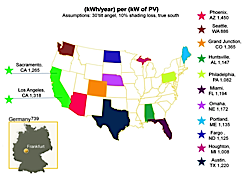Types of Solar
The three main functions of solar energy are to provide light, heat and electricity, and there is no doubt that this amazing alternative to fossil fuel is making a great impact on our lives today by providing these forms of energy to our homes and offices. However, there are pros and cons to using solar energy which must be considered, such as cost, suitability of use due to certain adverse climate conditions and application availability.
A change of mentality is required to consider solar energy-based living over fossil energy-based living. There are many accompanying advantages to solar power, which can encourage or motivate more widespread use of it. One of the advantages - or pros - is that it is free. The sun is always overhead to offer energy for our taking. The con is that its availability may be hindered by cloud cover. Secondly, solar energy is renewable.
Our planet is blessed with an unlimited supply of sun energy at its disposal. Thirdly, it is sustainable. There is no need to worry about the effect solar energy will have on the Earth's climate, or whether we will use up too much of it. There is a lesser need for dependence on fossil fuels for our energy needs, which indirectly results in a cleaner environment. Last, but not the least, it is an effective cost saver. After the initial investment, your fuel charges will drop to rock bottom once you have done the proper solar panel installation.
The three main functions of solar energy are to provide light, heat and electricity, and there is no doubt that this amazing alternative to fossil fuel is making a great impact on our lives today by providing these forms of energy to our homes and offices. However, there are pros and cons to using solar energy which must be considered, such as cost, suitability of use due to certain adverse climate conditions and application availability.
A change of mentality is required to consider solar energy-based living over fossil energy-based living. There are many accompanying advantages to solar power, which can encourage or motivate more widespread use of it. One of the advantages - or pros - is that it is free. The sun is always overhead to offer energy for our taking. The con is that its availability may be hindered by cloud cover. Secondly, solar energy is renewable.
Our planet is blessed with an unlimited supply of sun energy at its disposal. Thirdly, it is sustainable. There is no need to worry about the effect solar energy will have on the Earth's climate, or whether we will use up too much of it. There is a lesser need for dependence on fossil fuels for our energy needs, which indirectly results in a cleaner environment. Last, but not the least, it is an effective cost saver. After the initial investment, your fuel charges will drop to rock bottom once you have done the proper solar panel installation.

Despite all these advantages, there are some drawbacks to solar energy.
One of the main concerns of using solar energy is its lack of constant availability. Although limitless, the sun is not always directly available for our convenience. There is a need, therefore, to consider a supplementary energy source. Another related concern of using solar energy is the ability to store it. Although sunlight cannot be captured per se, its heat or converted electricity power can be stored for later usage.
A third disadvantage or concern is that the energy is widely dispersed. Its consistent quantum at any spot requires proper harnessing and storage so that it is in concentrated amounts for our convenience. The fourth disadvantage is that it is very much climate dependent. Where there is lesser sunlight, more advanced technology is required to capture the most sunlight to generate sufficient energy for daily use. These more complex systems of harnessing and storage may lead to higher costs of installation. Finally, the initial cost for installing solar energy devices is expensive. However, while a high upfront cost is typically required for installing a solar energy device, the cost is averaged out over the system’s lifetime functionality and ends up being much lower than fossil fuel powered energy.
There are many types of solar panels available to choose from: the solar hot water panel, the solar air heating panel and the solar electric panel, which normally comes in one or two large pieces of black rectangles. These solar panels are actually photovoltaic (PV) cells that are put together for an